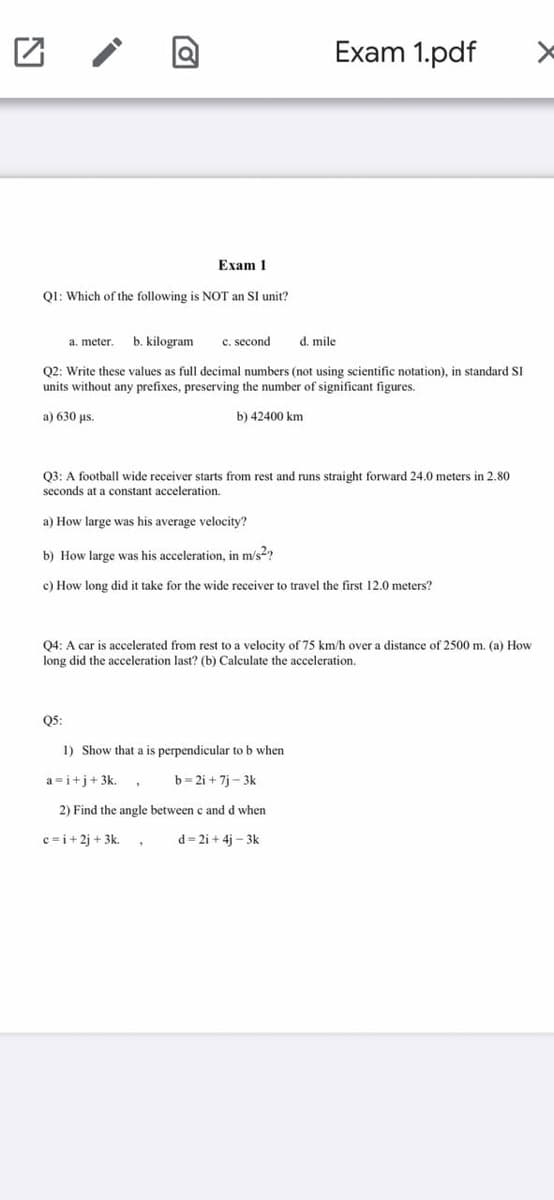An Introduction to Physical Science
14th Edition
ISBN:9781305079137
Author:James Shipman, Jerry D. Wilson, Charles A. Higgins, Omar Torres
Publisher:James Shipman, Jerry D. Wilson, Charles A. Higgins, Omar Torres
Chapter1: Measurement
Section: Chapter Questions
Problem 16E: The Hoover Dam Bridge connecting Arizona and Nevada opened in October 2010 ( Fig. 1.18). It is the...
Related questions
Question

Transcribed Image Text:Exam 1.pdf
Exam 1
Q1: Which of the following is NOT an SI unit?
b. kilogram
c. second
d. mile
a. meter.
Q2: Write these values as full decimal numbers (not using scientific notation), in standard SI
units without any prefixes, preserving the number of significant figures.
a) 630 us.
b) 42400 km
Q3: A football wide receiver starts from rest and runs straight forward 24.0 meters in 2.80
seconds at a constant acceleration.
a) How large was his average velocity?
b) How large was his acceleration, in m/s2?
c) How long did it take for the wide receiver to travel the first 12.0 meters?
Q4: A car is accelerated from rest to a velocity of 75 km/h over a distance of 2500 m. (a) How
long did the acceleration last? (b) Calculate the acceleration.
Q5:
1) Show that a is perpendicular to b when
a =i+j+3k.
b= 2i + 7i - 3k
2) Find the angle between c and d when
c=i+ 2j + 3k.
d = 2i + 4j – 3k
Expert Solution
This question has been solved!
Explore an expertly crafted, step-by-step solution for a thorough understanding of key concepts.
Step by step
Solved in 2 steps with 2 images

Knowledge Booster
Learn more about
Need a deep-dive on the concept behind this application? Look no further. Learn more about this topic, physics and related others by exploring similar questions and additional content below.Recommended textbooks for you

An Introduction to Physical Science
Physics
ISBN:
9781305079137
Author:
James Shipman, Jerry D. Wilson, Charles A. Higgins, Omar Torres
Publisher:
Cengage Learning

College Physics
Physics
ISBN:
9781285737027
Author:
Raymond A. Serway, Chris Vuille
Publisher:
Cengage Learning

College Physics
Physics
ISBN:
9781305952300
Author:
Raymond A. Serway, Chris Vuille
Publisher:
Cengage Learning

An Introduction to Physical Science
Physics
ISBN:
9781305079137
Author:
James Shipman, Jerry D. Wilson, Charles A. Higgins, Omar Torres
Publisher:
Cengage Learning

College Physics
Physics
ISBN:
9781285737027
Author:
Raymond A. Serway, Chris Vuille
Publisher:
Cengage Learning

College Physics
Physics
ISBN:
9781305952300
Author:
Raymond A. Serway, Chris Vuille
Publisher:
Cengage Learning

Physics for Scientists and Engineers, Technology …
Physics
ISBN:
9781305116399
Author:
Raymond A. Serway, John W. Jewett
Publisher:
Cengage Learning

Glencoe Physics: Principles and Problems, Student…
Physics
ISBN:
9780078807213
Author:
Paul W. Zitzewitz
Publisher:
Glencoe/McGraw-Hill

College Physics
Physics
ISBN:
9781938168000
Author:
Paul Peter Urone, Roger Hinrichs
Publisher:
OpenStax College